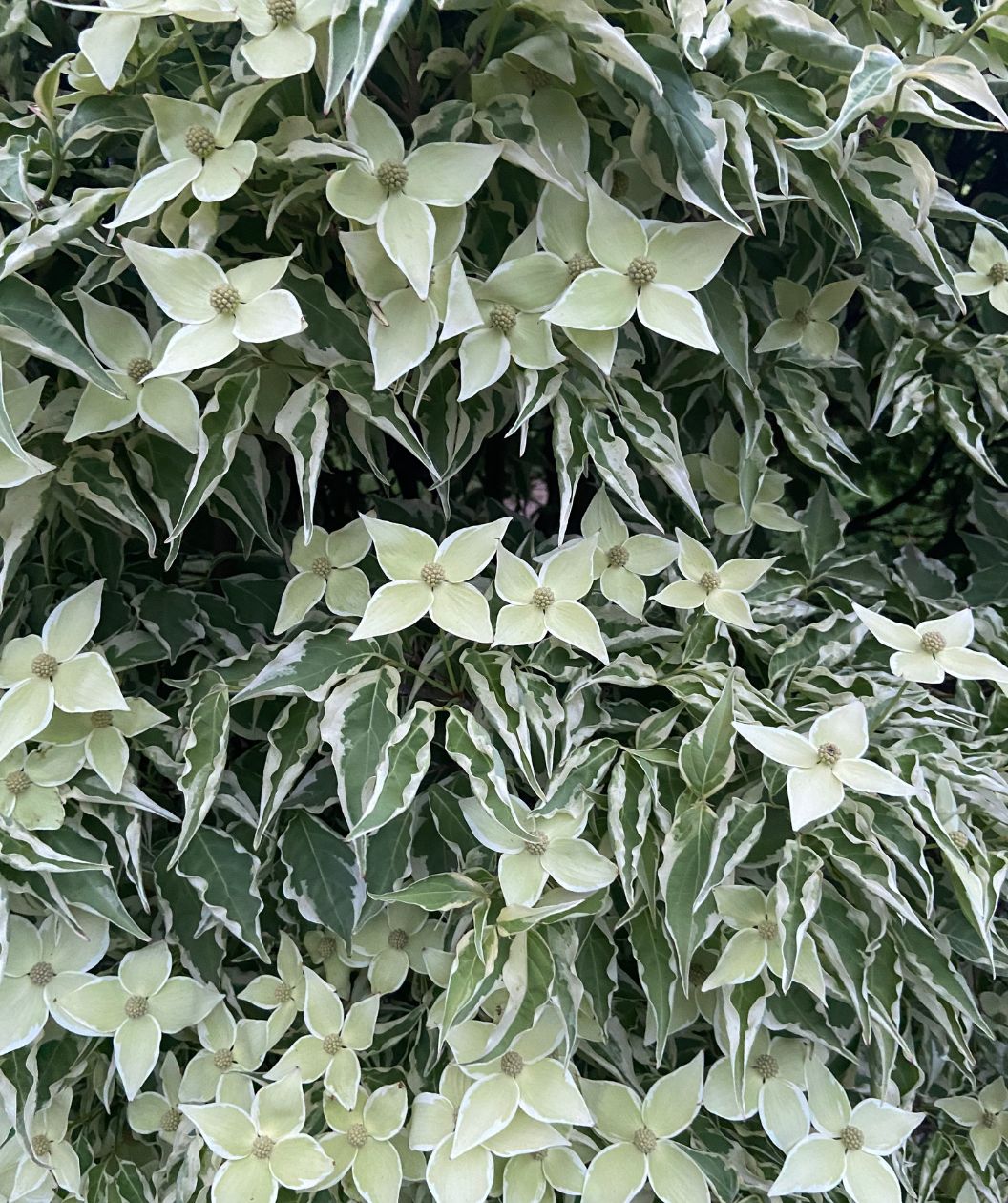




SHOW-STOPPING VARIEGATED FOLIAGE IN SPRING, SUMMER, AND FALL
FEATURES:
- In spring and summer, long leaves showoff vivid variegated colors of creamy white edging and deep green centers
- By fall, those colors transition to variegated hues of pinks, purples, and reds
- In late spring, four-petaled white blooms emerge, sometimes showing off wildly unique variegated flowers
- In late summer, large, edible, deep red berries appear
- Fruits can be eaten fresh off the tree or made into jams and jellies
- Best used as a stunning specimen tree, as a window tree, or near your back patio
- Hand Selected, Fresh from the Gorwer
- Ships on our trucks because of the size of the tree - does not fit in a box
Growth Facts
- Hardiness Zone: 5-8
- Mature Height: 15-20' tall
- Mature Width: 15-20' wide
- Exposure: Full Sun/Part Shade
- Spacing: 15-20' apart
SHOW-STOPPING VARIEGATED FOLIAGE IN SPRING, SUMMER, AND FALL
FEATURES:
- In spring and summer, long leaves showoff vivid variegated colors of creamy white edging and deep green centers
- By fall, those colors transition to variegated hues of pinks, purples, and reds
- In late spring, four-petaled white blooms emerge, sometimes showing off wildly unique variegated flowers
- In late summer, large, edible, deep red berries appear
- Fruits can be eaten fresh off the tree or made into jams and jellies
- Best used as a stunning specimen tree, as a window tree, or near your back patio
- Hand Selected, Fresh from the Gorwer
- Ships on our trucks because of the size of the tree - does not fit in a box
Growth Facts
- Hardiness Zone: 5-8
- Mature Height: 15-20' tall
- Mature Width: 15-20' wide
- Exposure: Full Sun/Part Shade
- Spacing: 15-20' apart
Why plant Wolf Eyes Variegated Japanese Dogwood?
Wolf Eyes Dogwood is a variegated Kousa Dogwood that will light up those shady corners of your landscape. This rare, choice flowering tree sports mint green foliage edged in white—so much white, in fact, that from a distance you might think the tree was in full bloom! When the creamy white flowers do arrive in late spring, there will be no mistaking those large, starry blooms for leaves. You’ll also want to revisit this spectacular variegated Dogwood tree in late summer when the cherry-sized red fruits ripen. They look like Cap’n Crunchberries, and they taste like papaya!
Japanese “Kousa” Dogwoods were unknown to the West until the 1870s, when Thomas Hogg, Jr. managed to send seeds to his brother in New York, who ran the nursery their father had established many years before. A U.S. Marshall in Japan, Hogg was able to get his hands on some of the choicest trees that we still grow today, like “Kousa” Dogwood, Japanese Stewartia, Katsura Tree, and Fragrant Snowbell. ‘Wolf Eyes’ was discovered in 1988 when it was found as a single branch mutation at Manor View Farm Nursery in Monkton, Maryland.
How to use Wolf Eyes Variegated Japanese Dogwood in the landscape?
Looking for a specimen tree? Well, you found one! Gee… where to start?! The leaves are long, pointy and kind of crinkly looking, not to mention variegated! The green centers are surrounded by creamy white margins. Four large white bracts (that look like flower petals) form the star-shaped "flowers" in late spring/summer. As flowers fade, red-orange fruit takes over in late summer. Let's not forget about the awesome pink to red fall color!! Like I said, this is the specimen tree you've been looking for!
Planting Zones
Hardiness Zone: 5-8
How To Plant Wolf Eyes Variegated Japanese Dogwood
Wolf Eyes Variegated Kousa Dogwood is an uncommon tree, which is surprising, given how easy it is to please and how much it has to offer. This naturally disease-resistant tree enjoys a site in part shade and wants regular irrigation but no “wet feet.” It has a preference for acid soils, so if rhododendrons and azaleas grow well in your area, this is definitely the tree for you (though it’s adaptable to other situations, too).
How To Water
Water weekly, or better yet, use the Bower & Branch® Water Element to deliver just the right amount of moisture to your tree throughout the growing season.
How To Fertilize
Incorporate Elements Starter Plant food granular form into the soil when planting. If planting in spring or summer, start fertilizing late fall using Elements Starter Plant food granular form on an annual basis each late fall. Continue this for the first three years to get your plant well established.
How To Prune
As your tree grows, you’ll probably want to remove the lowermost branches to show off that amazing jigsaw-puzzle bark! Pruning is best done shortly after the flowers are spent.
How Does Shipping Work?
Bower & Branch Trees, the real BIG trees, don’t fit in a box! Our big trees, sizes XL and bigger, require expert delivery and care, that means our extra-large trees are shipped on Bower & Branch trucks. We are the only ones who know how to ship our big and bigger trees and plants with tender loving care. We deliver your trees and plants directly to you. Ask Bower & Branch about planting services – we'd be happy to assist in installation.
*For Big trees and Shrubs, Size XL and bigger: Review our Seasonal Shipping Timelines and Policy here.
Your trees and plants are grown across the United States at various Bower & Branch Growers. Depending on your location, your plant orders may be shipped from various locations. Please expect orders with multiple items to be delivered over a number of days as a result. Orders made up of numerous items or selections will not arrive at your home on the same day.
Shipping Delays:
From time to time, Bower & Branch Growers may determine to delay order shipment based on various factors for plant health. Weather in your region, as well as, where your plants are grown, is always considered when shipping. Extreme weather conditions may delay some or all of your order. Bower & Branch allows our Growers to make final shipping decisions based solely to benefit your trees and plants’ health and success.
How Does Sizing Work?
The size of our trees have nothing to do with the container size like you may find elsewhere–big doesn't mean just height - it’s also vigor, age, and overall health. Other online retailers are going to tell you that a plant is a seven gallon, that means nothing to your tree or plant (or you.)
Our trees for sale online are graded on large, x-large, and even bigger sizes. This is because our trees are sized by their age—the higher the letter, the more mature the tree. The age determines the trees’ overall height, size of the trunk and the overall branch density.
All of these characteristics are what you should be looking for when choosing a tree for immediate impact and instant curb appeal. Our extra-large tree and plant sizes are sure to wow you and your neighbors!
See the size guides below.






Our Guarantees
3-YEAR-TREE GUARANTEE:
Bower & Branch offers a Three-Year Tree Guarantee on all of our trees, sizes X-Large and up. Only the finest and the most experienced growers are awarded the opportunity to grow for Bower & Branch, so we offer the best guarantee available.
If your tree(s) should fail for any reason during the three-year guarantee period, you will receive an online gift card in the amount that you originally spent on the tree.* You can then use this online gift card for any Bower & Branch Purchase.
* Bower & Branch provides online gift cards in the amount of the original purchase price of the tree(s). The amount does not include any additional costs such as delivery, planting, tax, or any other products or services. Online gift cards can be applied towards any Bower & Branch purchase on BowerandBranch.com and have no expiration dates. Bower & Branch does not guarantee tree replacement or availability of any desired product at any time. Cash refunds are not offered. Bower & Branch requires that all original tags and receipts are present when a guarantee request is initiated. The Bower & Branch Three-Year Guarantee only applies to plant material that has been planted in the ground. Container plantings are NOT covered.
At Bower & Branch, we do our best to honor all guarantee fulfillment requests to ensure customer satisfaction. However, we reserve the right to refuse the request if the required guarantee steps were not satisfied. Bower & Branch also reserves the right to deny any guarantee fulfillment request that is made as a result of animal damage, problems with plant hardiness and zone issues, or acts of nature (snow storms, hurricanes, and similar).
Reach out to a Plant Whisperer with any questions:
- Email: plantwhisperers@bowerandbranch.com
- Phone: 866-873-3888
- Or via Online Chat




